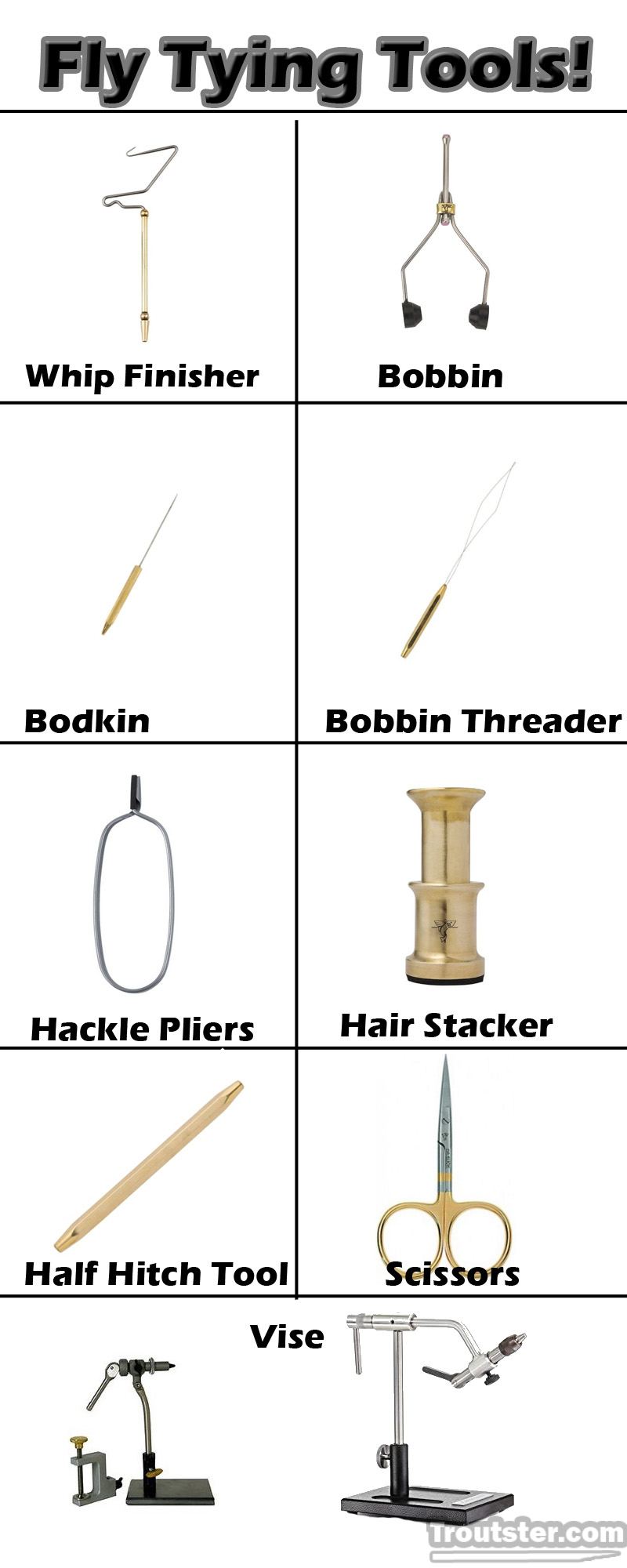This post was last updated on December 3rd, 2022 at 07:42 pm
Learn to Identify the Fly Tying Tools

How to Use Fly Tying Knot Tools
Below you will find the list of all of the fly tying tools included in the above infographic, with explanations about how to use each tool. Each tool used in tying flies has a special purpose. While you could certainly get by without owning every one of these tools, some of the items listed are certainly required.
Required Fly Tying Tools include:
- Bobbin
- Hackle pliers
- Scissors
- Vise
All of the other tools are optional, but will make the fly tying process for some particular flies go much smoother.
Whip Finishing Tool
This tool can be a little tricky to get used to, however they do come in handy while trying to tie the finishing knot on smaller sized flies. The whip finish knot is certainly the strongest and you won’t even have to use head cement most of the time after you tie the knot. The whip finishing tool in the image above is a Dr. Slick version and can be purchased on Amazon.
Bobbin
The bobbin is one fly tying tool that you really cannot get along without. It is the device that holds the thread while you wrap it around the hook. It provides just enough tension so you can easily wrap around the hook without the spool of thread going into free spool. The weight of the bobbin will keep the thread in position while you prepare your next batch of material to be tied to the hook.
Bodkin
This device is often used to apply head cement to flies. The sharp pointy end can be dipped into the cement to easily put small amounts of glue onto tricky smaller areas of flies. It is also used for picking out hair and flaring the legs on nymphs and streamer patterns. These often times have a half hitch tool built into one end providing a dual purpose tool.
Bobbin Threader
This simple tool has a thin wire that you place your fly tying thread into, from that point you slide the wire through your bobbin and your bobbin is threaded and ready to begin tying flies. This can come in handy when using thin threads, because they are often stubborn while trying to get the thread through the thin neck of the bobbin tool.
Hackle Pliers
These are another critical piece of equipment used in tying most flies. Using these pliers you can get a firm grip on the tip of very small hackles and easily maintain that grip while you wrap a hackle around a hook. Nearly every dry fly you could want to tie will be much easier using this tool, but they are frequently used for tying nymphs and streamer patterns as well.
Hair Stacker
This tool for use in tying flies is a great way to get a large clump of hair even on one end so you can tie perfect flies. It is commonly used in making large deer body hair patterns, because when you cut the hair off the hide it is often not perfectly symmetrical. Place the hair into this device, tap it a few times and all the hair will be even on one end ready to be tied to the hook.
Half Hitch Tool
This simple contraption is used in tying a basic overhand knot onto the head of your fly. This is one device that you can certainly live without, because the end of almost any ink pen will work just as well. If you feel the need to buy one, the Dr. Slick version shown in the image is made from high quality brass and will do nicely. You can find it for sale on Amazon.
Scissors
Perhaps the most important tool of all when it comes to tying great flies. A nice pair of scissors will keep your flies looking tidy and will easily trim a perfect cut from your valuable fly tying materials. If you are going to spend a lot of money on only fly tying related item, I would advise going with good quality scissors. We sell some very nice scissors in our fly fishing gear store that you might be interested in.
Fly Tying Vise
This is among one of the most important pieces of gear you can by in regards to tools using in fly tying. A good vise will allow you to keep a firm grip on a hook and make tying flies easier altogether. A nice rotary vise such as one made by Dyna-King or Renzetti will allow you to spin you fly in various directions easily, making tying on these tools a breeze. One vise shown in the image above is a Anvil Apex vise and seems to be a good bargain for a strong, durable piece of equipment. The Rotary vise shown is a Dyna-King Trekker Fly Tying Vise, also a good buy for the price.
In Conclusion, Fly Tying Tools Explained
Many of the tools shown above are made by Dr. Slick and can be found for sale at the following link: Dr. Slick Fly Tying on Amazon
Now that you know what all of these fly tying tools are used for, hopefully you are ready to put them to use and crank out some flies!
